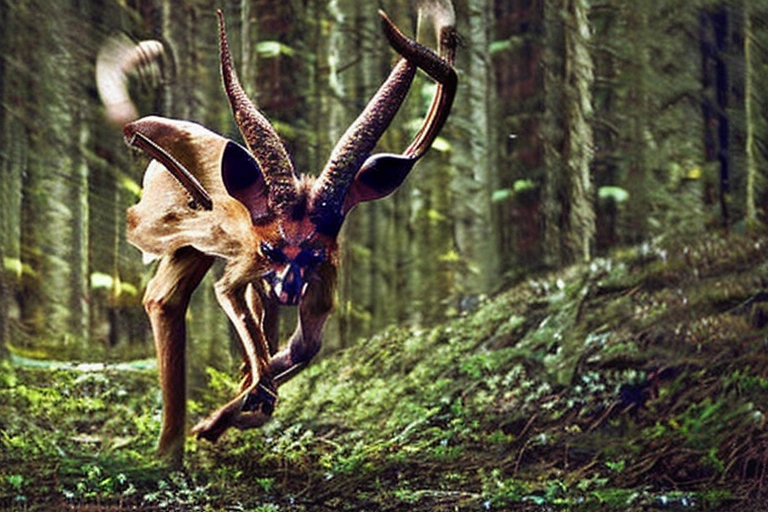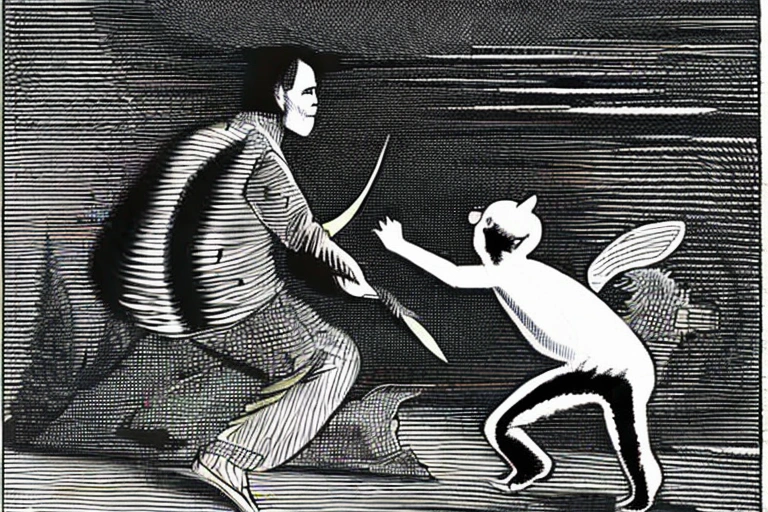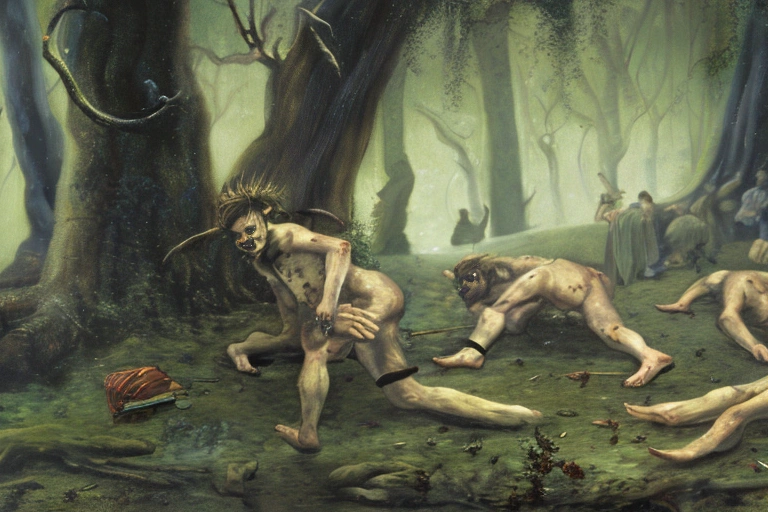When Fauns Attack: What to Do When You’re Trapped Among Their Groves
When it comes to mythical creatures, fauns may not be the first thing that comes to mind. But did you know that their groves can be dangerous? If you ever find yourself in a situation where you’re surrounded by these creatures, you may feel helpless. What should you do? This blog post will provide some tips on how to handle a faun attack and make it out alive!

Introduction to Fauns
If you find yourself lost in a forest of fauns, there are a few things you can do to protect yourself. First and foremost, remember that these creatures are shy and would rather run away from humans than fight. They may seem aggressive at first, but they usually won’t harm you if you don’t provoke them. If an encounter does occur, be sure to stay calm and avoid making any sudden movements. Stand your ground and use your voice to speak calmly to the fauns, explaining that you aren’t interested in harming them. Sometimes throwing something at them will scare them off; however this is not always effective. If all else fails, try running the other way – although it’s always best to avoid confrontations with wild animals in the first place!

Identifying Fauns in the Wild
When fauns attack, the most important thing to know is their behavior. They typically approach people from behind with curious expressions on their faces and then launch into a playful dance or Leap. If someone appears threatening, they’ll back away in alarm and may curl up into a ball to protect themselves.
If you’re stuck in the middle of a faun’s grove, your best bet is to remain still and avoid eye contact. Fauns are Friendly animals that will usually just want to play if approached in a non-threatening way. Try not to make too much noise – they like the tranquility of nature – and try not to show any fear or aggression. Above all else, relax!
Understanding Faun Behavior
The fauna in an area can tell you a lot about the environment and its inhabitants. In fact, the fauna might be your best guide to locating trees and other hidden prey. However, even experienced naturalists can get stumped by the behaviour of a particular faun species. Here are some tips for understanding what makes these creatures tick:
Fauns typically prefer areas that have dense undergrowth, because it provides protection from predators and allows them to ambush prey. They often gather in small groups of two or three individuals, which means that you should be more cautious when tracking them down. If you do encounter a group of fauns, try not to show fear or surprise; instead, maintain your composure and speak softly so as not to alarm them. Behave like a hunter rather than a victim – this will make the fauna less likely to attack first.
It’s also important to remember that certain types of behavior are linked with specific signals from other members of the faun community. For example, bouncing around nervously is one way that deer communicate their fearfulness to predators; similarly, primates use body language such as grooming and territorial displays to assert dominance over rivals or territory defenders). So if you see something out of the ordinary while exploring an unfamiliar woodland habitat – even if it’s just a seemingly peaceful creature behaving strangely – pay attention! Chances are good that there’s more going on beneath the surface than you’re aware of…

How to Avoid Fauns
If you find yourself in the midst of a faun colony, it’s important to understand their behavior in order to avoid getting trapped. Fauns are creatures of the forest, and as such, they are naturally inquisitive. They will explore any new area they encounter, and as such, it’s important to be aware of your surroundings at all times.
If you find yourself in a faun colony, the best course of action is to remain calm. Fauns are not aggressive by nature, and as long as you are polite and respectful, they will likely leave you alone. If they do not leave immediately, try to make yourself as small as possible and stay still. Fauns are not particularly good at spotting movement, so if you can keep still, they may not notice you.
What to Do if You Encounter a Faun
If you ever find yourself in the company of a faun, it is important to know how to deal with them. First and foremost, be aware that they are a territorial species and will protect their territory fiercely. Second, do not approach them from behind or from the side – they may believe you are trying to attack them. And finally, don’t make any sudden movements – if a faun perceives that you’re about to harm it, it will defend itself furiously.

Dealing with a Faun Attack
Identifying Fauns and Their Habits
If you come across a faun in the wild, your first instinct may be to run. But if you’re proactive and learn their behavior, you can mitigate risk and potentially have an enjoyable encounter. Fauns are creatures of the forest and enjoy roaming around ethereal gardens, so understanding their movements can help minimize surprise.
Generally speaking, when encountering a faun for the first time, take a few minutes to assess the scene before making any decisions about whether or not to approach. Look for clues about where they might be living or spending their day: Are there flowers nearby? Is there moss on the trees? Do any of the plants appear recently disturbed? The closer you get, the more likely it is that a faun will notice you. If they do, they may approach you, but they may also stay hidden in the foliage.
If a faun does come out and greets you, it’s important to remember that they are creatures of the forest and may not be used to humans. Be respectful and keep your voice low so as not to startle them. If a faun does start to act aggressively, don’t back down – fight back if necessary. Remember that a faun’s claws and teeth are less effective than a human’s, so use your fists or whatever else you have available to defend yourself.
If you’re lucky enough to get close enough to take a picture or video of a faun in action, be sure to document where you were when the encounter happened and what you were wearing so you can prove it was an authentic faun encounter.
Preparing for a Faun Encounter
If you find yourself surrounded by friendly fauns, don’t be alarmed. A few simple precautions can help keep you safe while exploring the woodland creatures’ domain.
First and foremost, always be aware of your surroundings when in their vicinity. Fauns are notoriously mischievous and may try to lure unsuspecting viewers into their nests for a tasty snack. If you see any signs that the fauns are about to attack or entice you into their territory, take action immediately!
Additionally, if you feel uncomfortable or threatened by the fauns surrounding you, it is best to back away slowly and avoid confrontation. Exhibiting hostile behavior will only incite an aggressive response from the animals and could result in injury or worse.
Finally, if you find yourself in a sticky situation, remember to use any physical weapons you may have at your disposal. Fauns are not as strong as humans and may be easily overpowered. If necessary, fight back using anything that comes to mind – stones, sticks, etc. – until help arrives.
Escaping from a Faun Attack
If you find yourself in the unfortunate position of being attacked by a faun, don’t panic. Here are some tips on how to avoid and escape from an attacking faun.
When Encountering a Faun:
- Make sure you’re aware of your surroundings at all times when near a faun’s habitat. Be cautious not to step on any hidden roots or trip over anyhidden branches.
- If you spot a foun dering in the woods, be patient and try not to scare it away. Most likely, the animal is just exploring its new surroundings. Give it time to get used to your presence before making any sudden movements.
- If the animal does become aggressive, remain calm and begin speaking softly to it in a soothing voice. Remember, fauns are creatures of nature and may not understand human words. Try gently waving your hands in front of the animal’s face or approaching it from the side instead of head-on.
- If all else fails, remember to use your arms and legs to defend yourself if necessary. Keep your hands close to your body at all times in case you need to grab onto something for support. And don’t be afraid to pepper the creature with quick jabs from either arm or leg – just make sure you don’t hit any vital areas!
Escaping From a Faun Attack:
- Once an attack begins, stay as still as possible and avoid making any sudden moves. Try not to scream or shout, which will only freak the faun out more.
- If you are able, try to use your arms and legs to defend yourself if necessary. Be especially careful not to hit any vital areas – aim for the animal’s eyes, nose or mouth instead!
- Remember, once a faun has attacked, there is very little you can do to stop it. So don’t waste time trying – just take flight as quickly as possible!

Common Tactics Used by Fauns
The fauns are a notoriously cunning and elusive species. Even seasoned adventurers can find themselves in trouble when encountering them, as their quick reflexes and clairvoyant abilities often lead them to trap unsuspecting creatures in their thick forests. While valiant efforts may occasionally lead to escape, many a hapless victim has succumbed to the attentions of these playful woodland folk. In this article we will take a look at some common tactics used by fauns in order to ensnare prey.

Strategies for Escaping a Faun Attack
Fauns are cunning creatures, and unless you’re familiar with their ways, it can be difficult to know what to do when they catch you in their territory. Here are some common tactics used by fauns in order to capture or kill prey:
- Disorientation: Fauns use various techniques to disorient their prey, such as making a loud noise or dancing around. If you’re caught off guard, your best bet is to try and fight back using whatever weapons you have at hand.
- Capture: If you find yourself trapped in a faun’s territory, the best course of action is usually submission. Keep quiet and avoid making any sudden movements; if all else fails, try and appeal to the creature’s sense of mercy (or desperation).
The Role of the Environment in a Faun Attack
When faced with a faun attack, the first step is to identify the environment in which you are trapped. Fauns favor cool, mountainous areas such as wooded glens or rocky cliffsides, making these areas ideal for traps. Look for natural openings-the smaller the better-into which you can escape and look for potential hiding spots. If all else fails, fight back! Fauns are half-man, half-animal and may be slower than you, but they’re also weaker and more easily startled than humans. Attack them with whatever weapons are available: clubs, rocks, daggers – anything that will disable or kill them quickly.

Understanding the Psychology of a Faun Attack
When a faun attacks, the first and most important thing to remember is that they are not trying to hurt you. In fact, they likely view you as part of their natural habitat. This means that they will probably react aggressively only if you threaten their safety or livelihood. Remember, these creatures have lived off the land for centuries and are fiercely territorial. If you try to scare them away by screaming or making sudden movements, they may become agitated and attack in defense of their territory.
If a faun does attack, use your bare hands to defend yourself and ward off any blows with your elbows or knees. Use whatever force is necessary to protect yourself from harm. Remember, the faun’s main goal is to scare you off, not actually injure you.”

Preparing for a Potential Faun Attack
When you’re out hiking or camping and you come across a faun, it’s important to know what to do if they start to become aggressive. Fauns are creatures of the forest, and as such, they can be territorial. If you’re in their territory, they may become agitated and attack.
If you’re attacked by a faun, the best thing to do is to stay calm. Don’t try to run away; they’ll only chase you further into the forest. Instead, try to stay still and avoid making any sudden movements. If you can, try to make yourself as small as possible so that the faun feels less threatened.
If the faun attacks you, don’t fight back. Instead, try to get away from them as quickly as possible. If you can’t get away, try to use your arms and legs to defend yourself. Be careful not to hit your head on any branches or rocks; if you do, you may be unconscious for a while.

Aftermath of a Faun Attack
After a faun attack, the immediate aftermath can be chaotic and confusing. There is the potential for injury from their sharp claws and teeth, as well as possible infectious substances they may have secreted on their fur or claws. If you are attacked by a faun, there are several steps you should take to protect yourself and minimize any injuries that may occur:
First and foremost, do not confront the animal. Fauns are incredibly territorial and will likely react aggressively if they feel threatened. Instead, try to back away slowly while keeping your eyes on the creature in case it makes an unexpected move. If it becomes impossible to flee safely, consider trying to communicate with the faun through signage or spoken language; however, keep in mind that most fauna are very elusive creatures who tend to avoid humans altogether. In cases where physical contact is unavoidable, use whatever means necessary to defend yourself – Mace/Axe/Polearm – but be aware that this could result in serious injury or death for both parties involved. Finally, call for help if needed; depending on location and circumstances (such as whether other animals may also be present), emergency services may arrive quickly enough to saved your life
In conclusion, it is important to understand the dangers of fauns and how to prepare for and respond to a potential attack. Knowing how to identify fauns in the wild, understanding their behavior, and learning strategies for escaping an attack can help keep you safe. We hope this article has provided you with useful information on how to handle a faun attack. For more helpful content on staying safe in the outdoors, be sure to check out our other articles.

Shoptimizer Blog
Meditation williamsburg kogi blog bushwick pitchfork polaroid austin dreamcatcher narwhal taxidermy tofu gentrify aesthetic.
Humblebrag ramps knausgaard celiac, trust fund mustache. Ennui man braid lyft synth direct trade.


